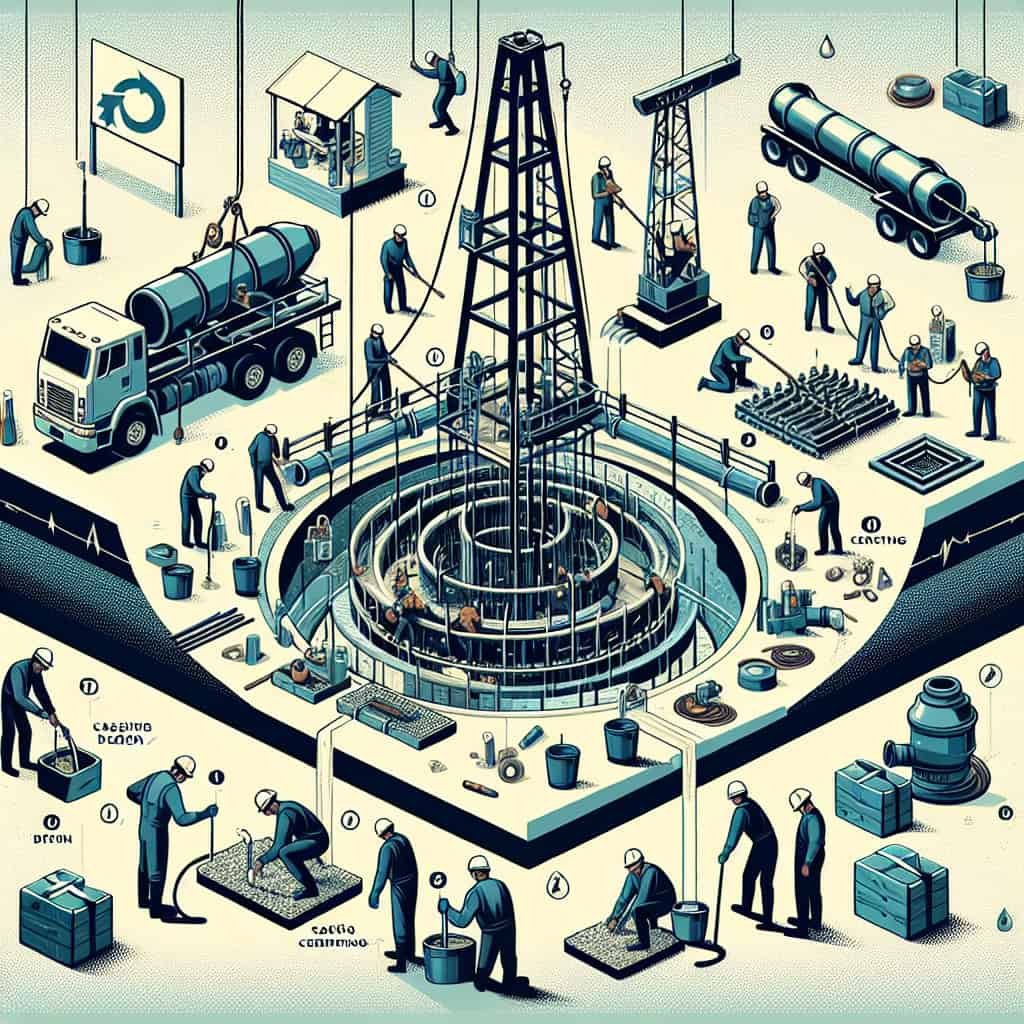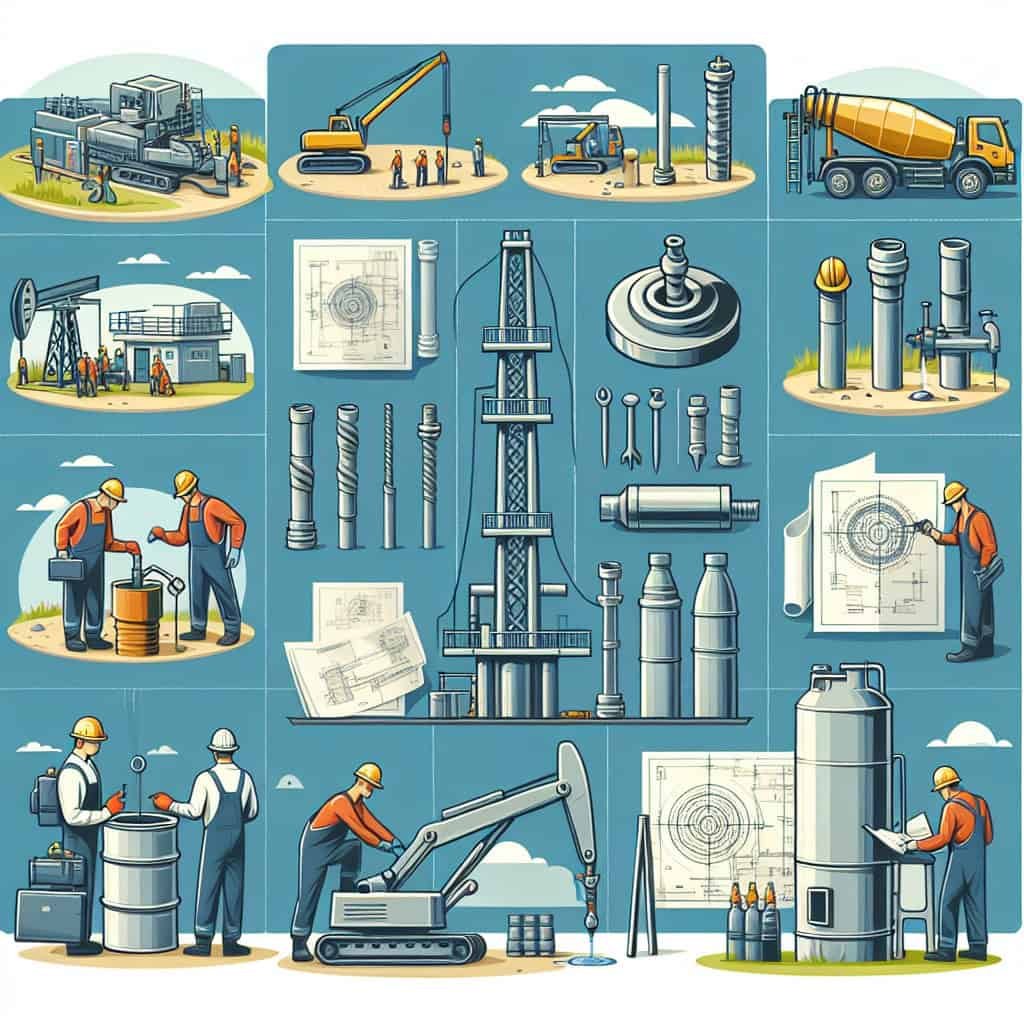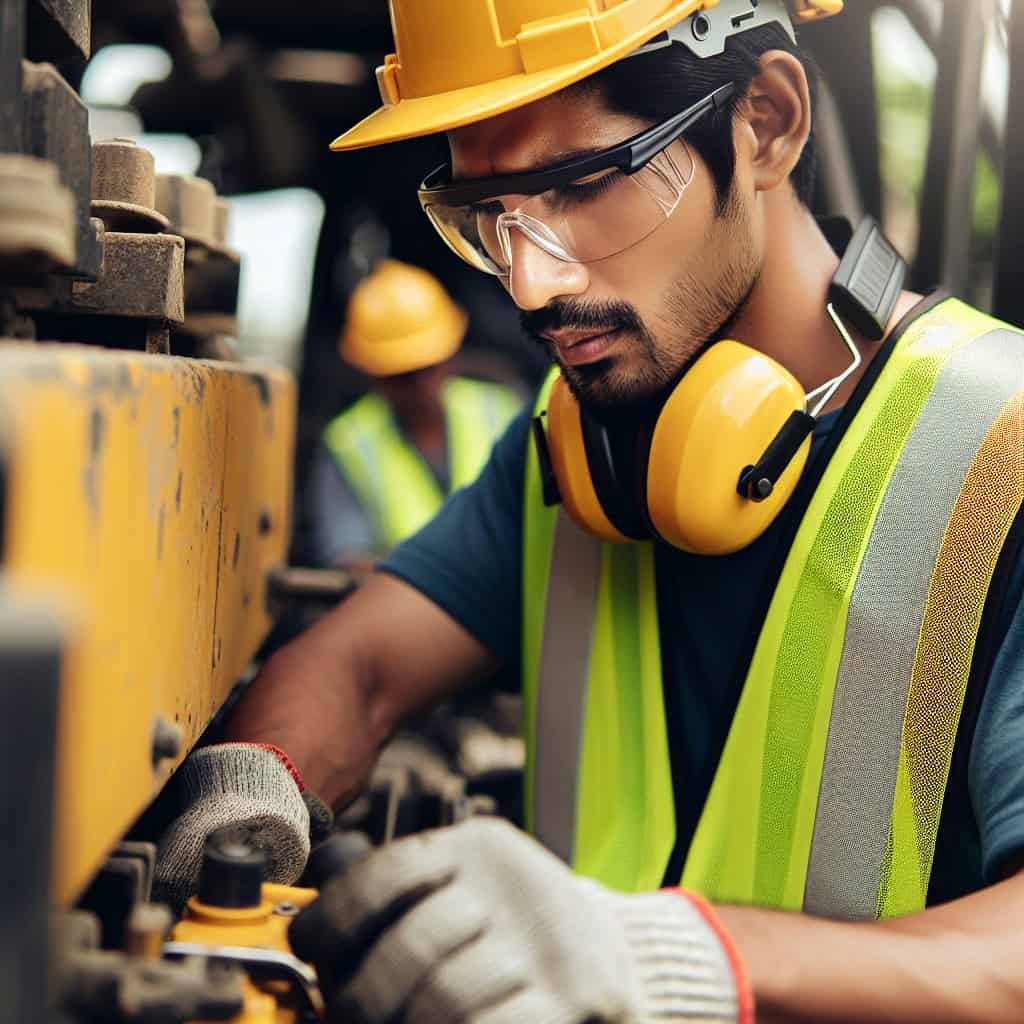If you’re looking to gain access to well construction and design guidelines, you’re in luck! This article is here to provide you with all the information you need on how to access these valuable resources. Whether you’re a professional in the industry or simply curious about the subject, we’ll guide you through the process of finding and utilizing these guidelines. So, let’s get started on your journey towards a better understanding of well construction and design!

Overview of Well Construction and Design Guidelines
Well construction and design guidelines are essential for ensuring the safe and efficient operation of wells. These guidelines provide valuable information and recommendations that help in the planning, design, construction, operation, and maintenance of different types of wells. By following these guidelines, you can ensure that your well is constructed to meet the necessary standards and requirements, minimizing the risks associated with the extraction of resources or the provision of essential services.
Purpose and Importance of Well Construction and Design Guidelines
The purpose of well construction and design guidelines is to establish a set of best practices and standards that promote the integrity and longevity of wells. These guidelines are crucial for various reasons. Firstly, they aim to protect the environment and public health by ensuring that wells are designed and constructed in a manner that prevents contamination of groundwater or the release of harmful substances. Additionally, these guidelines help reduce risks to personnel working on drilling rigs or operating wells. By following the guidelines, you can minimize accidents, equipment failures, and other hazards.
Benefits of Following Well Construction and Design Guidelines
Following well construction and design guidelines offers numerous benefits. Firstly, it ensures the safety of workers by minimizing the risks associated with drilling and operating wells. Secondly, it promotes environmental protection by preventing contamination of water sources. Moreover, adhering to these guidelines can improve the efficiency and productivity of wells, leading to enhanced resource recovery and cost savings. Additionally, it facilitates regulatory compliance, which is crucial for obtaining permits and licenses required for well construction and operation.
Government and Regulatory Agencies
Government and regulatory agencies play a vital role in establishing well construction and design guidelines. These agencies are responsible for developing and implementing regulations that govern well construction and operation. They aim to safeguard public health, protect the environment, and ensure the responsible and sustainable extraction of resources. By collaborating with industry experts, scientists, and other stakeholders, these agencies develop comprehensive guidelines that are based on scientific research, industry best practices, and regulatory requirements.

Role of Government and Regulatory Agencies in Establishing Well Construction and Design Guidelines
The role of government and regulatory agencies in establishing well construction and design guidelines is essential. These agencies conduct thorough research and assessments to understand the potential risks and impacts associated with various types of wells. They also evaluate current practices and industry standards to identify areas where improvements are necessary. Subsequently, they develop guidelines that address these concerns and promote responsible well construction and operation. Government agencies also play a crucial role in enforcing these guidelines and ensuring compliance within the industry.
National and International Guidelines and Standards
Well construction and design guidelines are developed at both national and international levels. Governments of individual countries establish their own guidelines to suit their specific geological and regulatory contexts. These guidelines take into account local conditions, such as hydrogeological characteristics, seismic activity, and environmental sensitivities. At the international level, organizations such as the International Organization for Standardization (ISO) and the American Petroleum Institute (API) develop standards that provide a global framework for well construction and design. These international guidelines harmonize practices and promote consistency in the industry, facilitating cross-border operations.

Role of Industry Associations and Organizations in Providing Well Construction and Design Guidelines
Industry associations and organizations play a crucial role in providing well construction and design guidelines. These organizations represent the collective knowledge and expertise of the professionals working in the sector. They collaborate with government agencies, academic institutions, and other stakeholders to develop comprehensive and up-to-date guidelines that reflect the latest industry advancements. Industry associations also facilitate knowledge sharing and capacity building through workshops, conferences, and training programs. They contribute significantly to improving practices, promoting innovation, and ensuring continuous improvement within the industry.
Specific Associations and Organizations for Different Well Types and Regions
There are numerous associations and organizations dedicated to providing well construction and design guidelines for different types of wells and regions. For example, the National Ground Water Association (NGWA) offers guidelines specifically tailored to water wells. This organization focuses on promoting best practices for drilling, construction, and management of groundwater wells. Similarly, associations like the Society of Petroleum Engineers (SPE) and the International Association of Drilling Contractors (IADC) provide guidelines for oil and gas wells. These organizations provide resources, publications, and technical guidance that help industry professionals meet the unique challenges associated with specific well types and geographic regions.

Accessing Well Construction and Design Guidelines Online
Accessing well construction and design guidelines has become easier with the advancements in technology. There are various online resources available that provide valuable information and resources related to well construction and design.
Government Websites and Online Portals
Government websites and online portals are excellent sources for accessing well construction and design guidelines. Most government agencies responsible for regulating well construction and operation have dedicated websites that provide comprehensive information on guidelines, regulations, and permitting processes. These websites often host downloadable documents, FAQs, and useful links to additional resources. Examples include the United States Environmental Protection Agency (EPA) and the Canada Energy Regulator (CER) websites.
Industry Association Websites
Industry association websites are another valuable resource for accessing well construction and design guidelines. These websites often feature publications, technical papers, and guidelines developed by the association and its members. Many associations provide free access to these resources, while some may require membership or subscription. The American Association of Drilling Engineers (AADE) and the International Geothermal Association (IGA) are examples of associations that offer extensive guidelines and resources on their websites.
Professional and Technical Research Papers and Journals
Professional and technical research papers and journals also provide valuable insights and guidelines on well construction and design. Various scientific publications and journals cover topics related to different aspects of well construction, including site selection, drilling techniques, wellbore stabilization, and more. Searching through academic databases, such as IEEE Xplore or Google Scholar, can lead to scholarly articles authored by experts in the field. These research papers often discuss new technologies, best practices, and emerging trends in well construction and design.
Well Construction and Design Guidelines for Different Well Types
Well construction and design guidelines vary depending on the type of well being considered. Different wells, such as water wells, oil and gas wells, geothermal wells, and monitoring wells, require specific considerations and guidelines to ensure their safe and effective construction and operation.
Guidelines for Water Wells
Water wells, which provide access to underground aquifers for drinking water supply, irrigation, or industrial purposes, have specific guidelines to ensure water quality and well integrity. These guidelines address aspects such as well casing and screen design, wellhead protection, and drilling techniques that minimize the risk of contamination.
Guidelines for Oil and Gas Wells
Oil and gas wells have their own set of guidelines due to the associated risks, complexities, and regulations involved in hydrocarbon extraction. These guidelines focus on well casing and cementing, drilling fluids, wellbore stability, and other considerations specific to the oil and gas industry. They also cover wellhead design, production testing, and well abandonment practices.
Guidelines for Geothermal Wells
Geothermal wells, which are used to harness the earth’s natural heat for energy generation, require unique guidelines to ensure the efficient and sustainable use of geothermal resources. These guidelines encompass drilling and completion techniques, well casing and cementing, and fluid management strategies. They also address the challenges of handling high temperatures and extreme conditions associated with geothermal reservoirs.
Guidelines for Monitoring Wells
Monitoring wells, used to assess groundwater quality, contaminant plumes, or subsurface conditions, have specific guidelines to enable accurate and reliable monitoring. These guidelines include considerations for well construction techniques to prevent cross-contamination, well materials that do not interfere with sampling or monitoring equipment, and appropriate well placement for effective data collection.

Design Considerations for Well Construction
Well construction involves several key design considerations that need to be addressed to ensure safe and effective operation. These considerations include:
Site Selection and Evaluation
Choosing the right site for well construction is crucial. Factors such as geological conditions, proximity to potential contaminants, and accessibility for drilling equipment must be considered. Site evaluation techniques, such as geophysical surveys and hydrogeological assessments, aid in determining the most suitable location for well construction.
Well Depth and Diameter
Determining the appropriate depth and diameter of a well is essential to meet the specific goals of the project. Factors such as the desired water or resource yield, aquifer characteristics, and drilling constraints influence these design considerations. It is crucial to account for future needs and potential variability in water or resource availability when determining well dimensions.
Casing and Cementing
Casing and cementing play a vital role in maintaining the integrity of the wellbore and preventing contamination. Guidelines provide recommendations for selecting appropriate casing materials, designing casing programs, and ensuring proper cementing practices. These guidelines consider factors such as the depth of the well, formation characteristics, and potential corrosive environments.
Wellhead Design
Wellhead design involves the selection and installation of the components at the top of the well. It includes elements such as casing heads, blowout preventers, and wellhead connectors. Guidelines for wellhead design focus on proper installation, maintenance, and pressure control to ensure safe and efficient well operation. Specific guidelines may vary depending on the type of well and the associated regulations.
Construction Techniques and Best Practices
Construction techniques and best practices play a critical role in the successful completion of a well. Employing the right drilling methods, utilizing appropriate equipment, and implementing wellbore stabilization measures are crucial to ensure safe and efficient operations.
Drilling Methods and Equipment
Drilling methods may vary depending on the type of well, geological conditions, and project requirements. Guidelines provide detailed information on various drilling techniques, such as rotary drilling, cable tool drilling, or directional drilling. They also offer recommendations for the selection and maintenance of drilling equipment, including drill bits, drill pipes, and drilling fluids.
Wellbore Stabilization and Fluids
Wellbore stabilization is essential to maintain the integrity of the wellbore during drilling and prevent issues such as formation collapse or wellbore collapse. Guidelines provide insights into wellbore stabilization techniques, including the use of drilling fluids, casing advancement methods, and well conditioning practices. Proper management of drilling fluids, such as mud systems, helps control pressure, minimize wellbore damage, and facilitate efficient drilling.
Well Completion and Development
Well completion and development involve the installation of well screens, sand control measures, and other components necessary to optimize well performance. Guidelines outline best practices for well completion, including selecting appropriate screen materials, gravel packing techniques, and zonal isolation methods. Effective well completion and development ensure optimal resource or water production, while minimizing complications such as sand production or well interference.
Well Testing and Analysis
Well testing and analysis are essential to assess the performance and productivity of a well. Guidelines provide recommendations for conducting well testing, pressure transient analysis, and production data interpretation. Well testing helps in evaluating factors such as formation properties, fluid flow rates, and potential reservoir damage. Proper testing and analysis enable informed decisions regarding stimulation techniques, resource recovery optimization, or necessary remedial actions.
Monitoring, Maintenance, and Rehabilitation
Monitoring, maintenance, and rehabilitation are critical aspects of well operation and management. Regular inspections, timely maintenance, and appropriate rehabilitation techniques help ensure the longevity and efficiency of wells.
Well Inspections and Monitoring
Regular well inspections and monitoring are essential to identify potential issues and ensure compliance with guidelines. Inspection protocols may include visual assessments, water quality sampling, and testing for well integrity. Monitoring programs enable the detection of changes in water levels, water quality, or production rates. These programs facilitate prompt identification of maintenance or rehabilitation requirements.
Maintenance and Repair Procedures
Maintenance and repair procedures are necessary to address issues identified during inspections or monitoring. Guidelines provide detailed recommendations for maintenance activities, such as pump maintenance, well cleaning, and equipment inspections. Additionally, they outline procedures for addressing common issues, such as casing leaks, wellhead malfunctions, or biofouling. Following these procedures ensures proper well function and reduces the risk of failures or environmental impacts.
Well Rehabilitation Techniques
Well rehabilitation techniques are employed to restore or enhance the performance of wells experiencing declining yields or compromised water quality. Guidelines offer guidance on various rehabilitation methods, including physical or chemical techniques to remove sources of fouling, improve permeability, or enhance wellbore conditions. Proper rehabilitation can extend the lifespan of wells and restore their productivity while reducing the need for drilling new wells.
Ensuring Regulatory Compliance
Regulatory compliance is crucial for well operators and owners. Adhering to permitting and licensing requirements, as well as fulfilling reporting and documentation obligations, is necessary to ensure that wells are constructed and operated legally and responsibly.
Permitting and Licensing Requirements
Well construction and operation often require permits and licenses from relevant government agencies. Guidelines provide information on the application processes, required documentation, and standards to meet for obtaining these permits or licenses. They also outline the obligations and responsibilities of the well operator to maintain compliance throughout the lifecycle of the well.
Reporting and Documentation Obligations
Well operators are typically required to submit reports and maintain proper documentation regarding well construction, operation, and maintenance activities. Guidelines specify the information that needs to be recorded and reported, such as drilling logs, water quality data, and well inspection reports. Compliance with reporting and documentation obligations ensures transparency, accountability, and facilitates regulatory oversight.
Continuous Improvement and Innovation
Continuous improvement and innovation play a significant role in advancing well construction and design practices. Industry associations, research institutions, and government agencies are actively involved in research and development initiatives to enhance technologies and techniques used in well construction.
Research and Development Initiatives
Various research and development initiatives are focused on improving well construction methods, materials, and equipment. These initiatives aim to develop innovative solutions that enhance well integrity, increase resource recovery, and minimize environmental impacts. Government funding, industry collaborations, and academic research contribute to these initiatives, ensuring that industry practices keep up with technological advancements and evolving challenges.
Emerging Technologies and Techniques
Emerging technologies and techniques have the potential to revolutionize well construction and design. Innovations such as advanced drilling methods, smart well monitoring systems, or geophysical imaging technologies offer new opportunities for improving efficiency, reducing costs, and decreasing environmental footprints. Guidelines often include emerging technologies as potential options, balancing their benefits and risks to support decision-making processes among industry professionals.
In conclusion, accessing well construction and design guidelines is essential for a successful and sustainable well construction project. These comprehensive guidelines, provided by government agencies, industry associations, and research papers, cover various aspects of well construction, from site selection to maintenance and rehabilitation. By following these guidelines, industry professionals can ensure safe and efficient well operations, protect the environment, and comply with regulatory requirements. Additionally, continuous improvement and innovation efforts contribute to advancing well construction practices and promoting sustainability in the industry.

